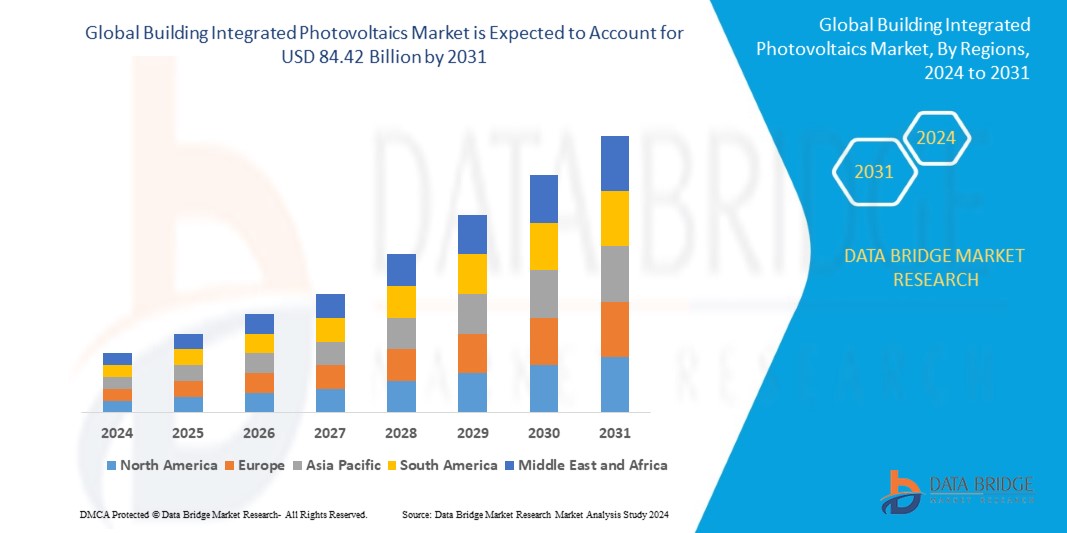世界の建物一体型太陽光発電市場の規模、シェア、トレンド分析レポート
Market Size in USD Billion
CAGR :
% 
| 2024 –2031 | |
| USD 24.29 Billion | |
| USD 84.42 Billion | |
|
|
|
>世界の建物一体型太陽光発電市場のセグメンテーション、製品別(屋根、壁一体型ソリューション、ガラス、ファサードなど)、用途別(産業用建物、商業用建物、住宅用建物)、技術別(結晶シリコンおよび薄膜技術)、販売チャネル別(直接販売および間接販売) - 2031年までの業界動向と予測。
世界の建物一体型太陽光発電市場分析
環境規制の強化と持続可能なエネルギーソリューションの需要により、世界の建物一体型太陽光発電 (BIPV) 市場は堅調な成長を遂げています。ファサードや屋根などの建物要素にソーラーパネルをシームレスに統合する BIPV システムは、エネルギー生成と美観の両方の利点を提供します。主な用途には住宅、商業、産業ビルがあり、エネルギーコストと炭素排出量の削減に役立ちます。技術の進歩と政府の支援政策が採用を促進し、エネルギー効率とグリーンビルディング基準の重要性が高まっています。イノベーションによってパフォーマンスが向上し、コストが削減されるため、市場は引き続き拡大すると予想されます。
世界の建物一体型太陽光発電市場規模
世界の建物一体型太陽光発電市場規模は、2023年に242億9,000万米ドルと評価され、2024年から2031年の予測期間中に16.85%のCAGRで成長し、2031年までに844億2,000万米ドルに達すると予測されています。市場価値、成長率、市場セグメント、地理的範囲、市場プレーヤー、市場シナリオなどの市場洞察に加えて、データブリッジ市場調査チームがまとめた市場レポートには、詳細な専門家分析、輸入/輸出分析、価格分析、生産消費分析、PORTER分析、PESTLE分析が含まれています。
世界の建物一体型太陽光発電市場の動向
「スマートビルディング統合」
スマート ビルディングの増加により、高度なビル管理システムとシームレスに統合できるビル統合型太陽光発電 (BIPV) システムの需要が大幅に増加しています。スマート ビルディングは、高度なテクノロジーとセンサーを使用して、エネルギー使用を最適化し、居住者の快適性を高め、全体的な効率を改善します。太陽光発電を行うと同時に建築材料としても機能する BIPV システムは、これらの目的によく適合しています。たとえば、スマート オフィス ビルの BIPV ファサードは、ビルのエネルギー管理システムと連携して、リアルタイムの気象データとエネルギー消費パターンに基づいてエネルギー生産を調整できます。同様に、住宅のスマート ホームでは、窓に埋め込まれた統合型ソーラー パネルがホーム オートメーション システムと連携して、晴天時に余剰電力を蓄えて後で使用するなど、エネルギー使用をより効率的に管理できます。この統合により、ビルのエネルギー効率目標がサポートされるだけでなく、BIPV 設備の機能と価値も高まります。
レポートの範囲と世界の建物一体型太陽光発電市場のセグメンテーション
|
属性 |
建物一体型太陽光発電の主要市場洞察 |
|
対象セグメント |
製品別: 屋根、壁一体型ソリューション、ガラス、ファサードなど 用途別:工業ビル、商業ビル、住宅ビル 技術別:結晶シリコンと薄膜技術 販売チャネル別:直接販売と間接販売 |
|
対象国 |
米国、カナダ、メキシコ、ドイツ、フランス、英国、オランダ、スイス、ベルギー、ロシア、イタリア、スペイン、トルコ、その他のヨーロッパ諸国、中国、日本、インド、韓国、シンガポール、マレーシア、オーストラリア、タイ、インドネシア、フィリピン、その他のアジア太平洋諸国、サウジアラビア、UAE、南アフリカ、エジプト、イスラエル、その他の中東およびアフリカ諸国、ブラジル、アルゼンチン、その他の南米諸国 |
|
主要な市場プレーヤー |
Merck KGaA(ドイツ)、Trina Solar(中国)、CertainTeed, LLC.(フランス)、Tesla(米国)、JA Solar(中国)、Canadian Solar(カナダ)、Changzhou Almaden Co. Ltd(中国)、Waaree Energies Ltd.(インド)、Hanergy Thin Film Power Group(中国)、京セラ株式会社(日本)、Heliatek GmbH(ドイツ)、Onyx Solar Group LLC.(スペイン)、MetSolar(台湾)、The Solaria Corporation(米国)、Suntegra(米国) |
|
市場機会 |
|
|
付加価値データ情報セット |
データブリッジ市場調査チームがまとめた市場レポートには、市場価値、成長率、市場セグメント、地理的範囲、市場プレーヤー、市場シナリオなどの市場洞察に加えて、詳細な専門家分析、輸入/輸出分析、価格分析、生産消費分析、PORTER分析、PESTLE分析が含まれています。 |
建物一体型太陽光発電市場の定義
建物一体型太陽光発電では、ファサード、屋根、窓などの建築材料に太陽光発電システムを直接組み込むことになります。BIPV システムは、建物の建築機能部品として機能しながら、再生可能な太陽エネルギーを生成します。この市場には、住宅と商業施設の両方でエネルギー効率と持続可能性を高めることを目的としたさまざまな技術とアプリケーションが含まれます。
ビル統合型太陽光発電市場の動向
ドライバー
- 持続可能なエネルギーに対する需要の増加
持続可能なエネルギーに対する需要の高まりは、建物一体型太陽光発電市場の大きな推進力となっています。環境への懸念と規制が強化されるにつれ、二酸化炭素排出量を最小限に抑える再生可能エネルギー ソリューションへの要求が高まっています。太陽光技術を建築材料に直接統合する BIPV システムは、建物の美観を高めながらクリーン エネルギーを生成する効果的な方法を提供します。持続可能性の目標との整合性により、BIPV は、グリーン ビルディング基準を満たし、環境への影響を軽減することを目指す開発者や不動産所有者にとって魅力的な選択肢となっています。
- 都市化とグリーンビルディングのトレンド
都市化とグリーン ビルディングのトレンドにより、建物に統合された太陽光発電の需要が大幅に増加しています。都市が拡大し、持続可能性が焦点となるにつれて、エネルギー効率が高く、見た目にも美しいソリューションを新規および既存の構造に統合することがますます重要になっています。建物のファサード、屋根、窓にシームレスに溶け込む BIPV システムは、再生可能エネルギーを生成すると同時に建物の外観を向上させることで、これらの目標の達成に貢献します。この二重の機能は、スマートで環境に優しい都市開発に向けた現代の動きと一致しています。
機会
- 改修と改造
改修と改造は、建物に統合された太陽光発電システムにとって大きな市場機会をもたらします。建物が新しいエネルギー効率基準を満たすために更新されたり、外観が近代化されたりすると、BIPV システムを改修にシームレスに統合して、機能的および美的メリットを提供できます。これらのシステムは、再生可能な電力を生成することでエネルギー コストの削減に貢献し、先進的で洗練されたデザインで建物の外観を向上させます。これにより、BIPV は、持続可能性の目標を順守しながら既存の構造をアップグレードしたいと考えている不動産所有者にとって魅力的な選択肢になります。既存の建物を BIPV システムで改造する可能性は、大きく成長している市場セグメントを生み出します。
- スマートビルディングテクノロジーとの統合
ビル一体型太陽光発電とスマート ビルディング テクノロジーおよびスマート グリッドの統合は、大きな市場機会をもたらします。スマート ビルディングに高度なエネルギー管理システムが組み込まれるようになるにつれて、BIPV はこれらのシステムと連携する再生可能エネルギーを生成することで重要な役割を果たすことができます。たとえば、BIPV システムをスマート グリッドと統合して、エネルギー使用を最適化し、エネルギー貯蔵を管理し、リアルタイムでビルの効率を高めることができます。この相乗効果は、エネルギーの節約とコスト削減をサポートするだけでなく、インテリジェントで自動化されたビル ソリューションへのトレンドの高まりにも合致し、現代の建築における BIPV システムの魅力と機能性を高めます。
制約/課題
- 規制とコンプライアンスの問題
規制とコンプライアンスの問題は、ビル一体型太陽光発電市場にとって大きな課題です。地域によって建築材料や再生可能エネルギー システムに関する基準や規制が異なるため、BIPV 設置の承認プロセスが複雑になることがあります。これらの多様な要件により、プロジェクト承認の遅れ、コンプライアンスを満たすためのコストの増加、管理上の負担の増加につながる可能性があります。これらの規制環境に対処するには慎重な計画が必要であり、BIPV 展開の全体的な実現可能性と速度に影響を与える可能性があります。これらの複雑さを管理しながら地域のコードと基準を遵守することが、BIPV の統合を成功させる上で重要です。
- 建物設計との複雑な統合
太陽光発電システムをさまざまな建築設計や建築材料に統合することは、精密なエンジニアリングとカスタマイズが必要なため、大きな課題となります。建物一体型太陽光発電 (BIPV) システムが、美観と機能効率を維持しながら、既存および新規の建物構造の両方にシームレスに溶け込むようにするには、慎重な計画と実行が必要です。この複雑さにより、設計と設置のプロセスが複雑になり、多様な建築様式や構造要件に合わせた高度なソリューションが必要になります。
例えば、
- 2022 年 12 月、Graham Engineering は、ニューヨーク市のハイテク住宅プロジェクトに高度な押し出し技術を組み込む際に、統合の課題に直面しました。このプロジェクトでは、BIPV システムをさまざまな建築要素や建設資材と融合させる必要がありました。Graham Engineering は建築家と協力し、プロジェクトの美観と性能の両方の要件を満たすカスタム押し出しプロファイルを開発しました。
この市場レポートでは、最近の新しい開発、貿易規制、輸出入分析、生産分析、バリュー チェーンの最適化、市場シェア、国内および現地の市場プレーヤーの影響、新たな収益源の観点から見た機会の分析、市場規制の変更、戦略的市場成長分析、市場規模、カテゴリ市場の成長、アプリケーションのニッチと優位性、製品の承認、製品の発売、地理的拡大、市場における技術革新などの詳細が提供されます。市場に関する詳細情報を取得するには、アナリスト ブリーフについて Data Bridge Market Research にお問い合わせください。当社のチームが、情報に基づいた市場決定を行い、市場の成長を実現できるようお手伝いします。
建物一体型太陽光発電市場の展望
市場は、製品、アプリケーション、販売チャネル、テクノロジーに基づいてセグメント化されています。これらのセグメントの成長は、業界のわずかな成長セグメントの分析に役立ち、ユーザーに貴重な市場の概要と市場の洞察を提供し、コア市場アプリケーションを特定するための戦略的決定を下すのに役立ちます。
製品
- 屋根
- 壁統合ソリューション
- ガラス
- ファサード
- その他
応用
- 工業ビル
- 商業ビル
- 住宅
テクノロジー
- 結晶シリコン
- 薄膜技術
販売チャネル
- 直接販売
- 間接販売
統合型太陽光発電市場の地域分析
市場は分析され、上記のように製品、アプリケーション、販売チャネル、テクノロジー別に市場規模の洞察と傾向が提供されます。
市場に含まれる国は、米国、カナダ、メキシコ、ドイツ、フランス、英国、オランダ、スイス、ベルギー、ロシア、イタリア、スペイン、トルコ、その他のヨーロッパ諸国、中国、日本、インド、韓国、シンガポール、マレーシア、オーストラリア、タイ、インドネシア、フィリピン、その他のアジア太平洋諸国、サウジアラビア、UAE、南アフリカ、エジプト、イスラエル、その他の中東およびアフリカ諸国、ブラジル、アルゼンチン、その他の南米諸国です。
ヨーロッパは、持続可能性に対する強力な規制支援、グリーンビルディング基準の採用率の高さ、再生可能エネルギープロジェクトへの大規模な投資により、世界の建物一体型太陽光発電市場を支配しています。ドイツやフランスなどの国は、進歩的な政策、多額の補助金、エネルギー効率の高いソリューションを建物の設計に統合することに重点を置いて主導しています。
アジア太平洋地域は、世界の建物一体型太陽光発電市場においても最高の成長率を示しています。この成長は、都市化の加速、グリーンビルディングプロジェクトへの投資の増加、再生可能エネルギー導入に対する政府の強力なインセンティブによって推進されています。インドや中国などの国々における急速なインフラ開発は、この地域における BIPV 技術の拡大をさらに推進しています。
レポートの国別セクションでは、市場の現在および将来の傾向に影響を与える国内市場における個別の市場影響要因と規制の変更も提供しています。下流および上流のバリュー チェーン分析、技術動向、ポーターの 5 つの力の分析、ケース スタディなどのデータ ポイントは、個々の国の市場シナリオを予測するために使用される指標の一部です。また、国別データの予測分析を提供する際には、グローバル ブランドの存在と可用性、および地元および国内ブランドとの競争が激しいか少ないために直面する課題、国内関税と貿易ルートの影響も考慮されます。
建物一体型太陽光発電の市場シェア
市場競争環境では、競合他社ごとの詳細が提供されます。詳細には、会社概要、会社の財務状況、収益、市場の可能性、研究開発への投資、新しい市場への取り組み、世界的なプレゼンス、生産拠点と施設、生産能力、会社の強みと弱み、製品の発売、製品の幅と広さ、アプリケーションの優位性などが含まれます。提供される上記のデータ ポイントは、市場に関連する会社の焦点にのみ関連しています。
建物一体型太陽光発電市場で事業を展開しているリーダー企業は次のとおりです。
- メルクKGaA(ドイツ)
- トリナ・ソーラー(中国)
- CertainTeed LLC. (米国)
- テスラ(米国)
- JAソーラー(中国)
- カナディアン・ソーラー(カナダ)
- 常州アルマデン株式会社(中国)
- Waaree Energies Ltd.(インド)
- 漢能薄膜発電グループ(中国)
- 京セラ株式会社(日本)
- Heliatek GmbH (ドイツ)
- オニキスソーラーグループLLC(米国)
- メットソーラー(米国)
- ソラリアコーポレーション(米国)
- サンテグラ(アメリカ)
世界の建物一体型太陽光発電市場の最新動向
- カナダの太陽光発電会社ミトレックスは2023年4月、米国に2.5GWの太陽光パネル工場を開設する意向を発表した。目標は年間2.5GWの生産能力を持つ施設を持つことで、当初は大部分を従来の太陽光パネルに充てる。ミトレックスはガラスを製造しており、これにより同社は特殊な色付き太陽光パネルの製造をコントロールすることができる。この垂直統合は米国の工場でも採用される予定だ。
- 2023年9月、マキシオンソーラーテクノロジーズは、コンプリートソラリアのディーラーチャネル事業と、シングルセルソーラーパネル技術に関するソーラーパネル特許ポートフォリオを買収すると発表した。
SKU-
世界初のマーケットインテリジェンスクラウドに関するレポートにオンラインでアクセスする
- インタラクティブなデータ分析ダッシュボード
- 成長の可能性が高い機会のための企業分析ダッシュボード
- カスタマイズとクエリのためのリサーチアナリストアクセス
- インタラクティブなダッシュボードによる競合分析
- 最新ニュース、更新情報、トレンド分析
- 包括的な競合追跡のためのベンチマーク分析のパワーを活用
調査方法
データ収集と基準年分析は、大規模なサンプル サイズのデータ収集モジュールを使用して行われます。この段階では、さまざまなソースと戦略を通じて市場情報または関連データを取得します。過去に取得したすべてのデータを事前に調査および計画することも含まれます。また、さまざまな情報ソース間で見られる情報の不一致の調査も含まれます。市場データは、市場統計モデルと一貫性モデルを使用して分析および推定されます。また、市場シェア分析と主要トレンド分析は、市場レポートの主要な成功要因です。詳細については、アナリストへの電話をリクエストするか、お問い合わせをドロップダウンしてください。
DBMR 調査チームが使用する主要な調査方法は、データ マイニング、データ変数が市場に与える影響の分析、および一次 (業界の専門家) 検証を含むデータ三角測量です。データ モデルには、ベンダー ポジショニング グリッド、市場タイムライン分析、市場概要とガイド、企業ポジショニング グリッド、特許分析、価格分析、企業市場シェア分析、測定基準、グローバルと地域、ベンダー シェア分析が含まれます。調査方法について詳しくは、お問い合わせフォームから当社の業界専門家にご相談ください。
カスタマイズ可能
Data Bridge Market Research は、高度な形成的調査のリーダーです。当社は、既存および新規のお客様に、お客様の目標に合致し、それに適したデータと分析を提供することに誇りを持っています。レポートは、対象ブランドの価格動向分析、追加国の市場理解 (国のリストをお問い合わせください)、臨床試験結果データ、文献レビュー、リファービッシュ市場および製品ベース分析を含めるようにカスタマイズできます。対象競合他社の市場分析は、技術ベースの分析から市場ポートフォリオ戦略まで分析できます。必要な競合他社のデータを、必要な形式とデータ スタイルでいくつでも追加できます。当社のアナリスト チームは、粗い生の Excel ファイル ピボット テーブル (ファクト ブック) でデータを提供したり、レポートで利用可能なデータ セットからプレゼンテーションを作成するお手伝いをしたりすることもできます。





